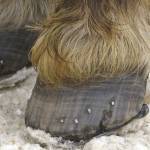Large Body, Small Feet, and Hours in the Stall: Problems for Horses

When we consider that horses are walking around on the anatomic equivalent of fingertips, it’s no surprise that they sometimes have pain in the tissues and joints that make up the equine hoof.
Thoroughbred hooves are particularly small, with relatively thin walls and soles. An article by veterinarian Scott Morrison published in Equine Disease Quarterly states that while these small hooves are capable of handling major impacts such as the forces generated by a galloping horse, hoof capsule deformities like collapsed heels are the result of hours of standing nearly motionless in a stall. This seeming paradox occurs because when horses are in motion, the hoof flexes slightly, allowing the load to be shared by various structures and tissues. Horses that stand still for many hours each day are forcing their hooves to bear weight in a static manner. Hoof structures thus become fatigued and begin to deform, manifesting as flattened soles, underrun heels, and sheared heel bulbs. Hooves in this weakened state are more easily injured, according to Morrison.
The author points out that when racehorses run on dirt or turf, the ground surface packs into the bottom of the hoof, providing support to the sole and arch. Stalled horses are supporting their weight only on the hoof wall, and using heart bar shoes, stabilizer plates, or temporary arch supports can be helpful while horses are in their stalls.
Regular and correct hoof trimming and shoeing can help to avoid hoof deformation, and can also begin to correct unbalanced and distorted hooves. Morrison said that the long-toe/short-heel shape is a common imbalance. Balanced shoeing can help to distribute force over the entire hoof, lessening the chance of injury.








